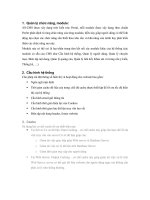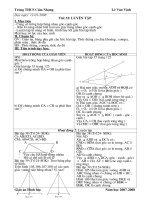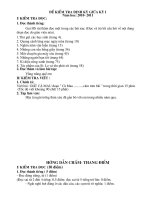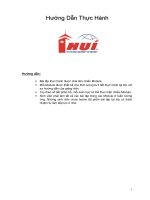Module 2c 2022 KLA304 604
Bạn đang xem bản rút gọn của tài liệu. Xem và tải ngay bản đầy đủ của tài liệu tại đây (2.69 MB, 34 trang )
KLA 304 and 604
Foodborne Pathogens
Module 2C
EMERGING FOODBORNE PATHOGENS
Definitions
How is an “emerging pathogen” defined?
1.Increase in prevalence (or going to…)
2.New (virulent) strain varieties e.g. mutation,
genetic rearrangement
3.Infections appear in “new populations”
i.e. expansion or change in susceptible groups
Covid-19 is a classic example for emerging
(radically so)
Definitions cont’d
4.Old infection spreads by a new
transmission route
5. Unknown, unstudied or
unsuspected organisms that
cause disease or poisoning
– microbes to be “watched” that
is they could re-emerge i.e. measles,
syphilis
Emergence factors
Factors that could influence or induce the emergence or
re-emergence of foodborne pathogens
1. Microbial adaptation to stress - increased resistance to food
processing/preservation hurdles, antibiotic resistance
2. Climate change – increased populations in reservoirs?
Increased range of disease vectors.
3. Ecosystem change – as above
4. Centralisation of food manufacture and distribution
5. Human behaviour – increased consumption of
RTE foods, abuse of used-by-dates
6. Aging populations – decreased immune responses
Emergence factors
Factors that could influence or induce the
emergence or re-emergence of pathogens
7. Poverty
8. Disruption to public health
services/measures e.g. war, cost
savings
9. Lack of vigilance/surveillance
e.g. cost savings, complacency.
10. Intent to harm …bioterrorism
Interaction of factors
Contamination or presence
in the supply chain/
Pathogen
environment
Environment
Production systems
Adaptation
Distribution systems
Change
“Consumer environment”
Human host
Immune status
Quality of life
Unknown factors
-Unknown etiology e.g. 80% of foodborne illnesses
-How much sickening is due to still unknown microbes/
viruses?
- Are there unforeseen (or invisible) underlying trends?
Most diseases that are emerging are viral. Bacterial infectious agents include
AMRs, Listeria, anthrax, cholera, diphtheria, bubonic plague, E. coli O104:H4.
Highly contextual. Time scale is 20-25 years.
1. Increase in prevalence
Considered over a 20 to 25-year (generational)
timescale
Some examples:
- Salmonella Enteriditis associated with eggs,
replacing Salmonella Typhimurium
- Trematode infections, increasing in tropical countries
- Brucella, Arcobacter (zoonotic origins)
- Non-O157 E. coli relacing O157 strains
- Hepatitis E virus
- Clostridioides difficile
Foodborne pathogens that have emerged since the 1980s ––
most recent emergences are highlighted in red
•
•
•
•
Campylobacter jejuni
Campylobacter fetus ssp. fetus – probably zoonotic
Cryptosporidium parvum
Cyclospora cayetanensis – Central America
• Non O157 Escherichia coli e.g. O104:H4 outbreak in Germany
•
•
•
•
•
Listeria monocytogenes
Salmonella Enteritidis and other serotypes – increasing in Australia
Invasive non-typhoidal Salmonella (Africa mainly)
Brucella spp. – brucellosis – acquired from raw animal products
Arcobacter butzleri – as Brucella also contaminated water
• Clostridioides difficile – spore contamination of raw foods?
• Nitzschia pungens (cause of amnesic shellfish poisoning, not
observed since 1987)
• Trematode infections – below the radar – include liver flukes, lung
flukes and intestinal flukes
Angiostrongylus cantonensis
Rat lungworm
Infestation in eye
(of a dog)
Foodborne viruses
Hepatitis: Hepatitis A, Hepatitis E
Gastroenteritis: Norovirus, Sapovirus, Rotavirus,
Astrovirus
Polyinfections (eyes, lungs, intestine): Adenovirus
Neurological (poliomyelitis etc.): Enterovirus
Foodborne viruses: an emerging problem.
Koopmans M, Duizer E.
National Institute of Public Health and the Environment (RIVM), Antonie van Leeuwenhoeklaan,
9, NL-3720 BA Bilthoven, The Netherlands.
Several groups of viruses may infect persons after ingestion and then are shed via stool. Of
these, the norovirus (NoV) and hepatitis A virus (HAV) are currently recognised as the most
important human foodborne pathogens with regard to the number of outbreaks and people
affected in the Western world. NoV and HAV are highly infectious and may lead to widespread
outbreaks. The clinical manifestation of NoV infection, however, is relatively mild. Asymptomatic
infections are common and may contribute to the spread of the infection. Introduction of NoV in
a community or population (a seeding event) may be followed by additional spread because of
the highly infectious nature of NoV……
Brucellosis (what is called in human infections) in its various manifestations:
•Malta fever/Bang's disease
•Undulant fever/enzootic abortion (enzootic – epidemic in animals –
normal situation)
•Mediterranean fever/epizootic abortion (abnormal events)
•Rock fever of Gibraltar/slinking (abortion) of calves
•Gastric fever/ram epididymitis (infection of the testicles )
•Contagious abortion/spontaneous abortion
•Other infections – endocarditis, meningitis etc.
Class Alphaproteobacteria
Human disease bacteria and plant
symbionts are related!
Environmental bacteria – soil,
plants, lakes, seawater…
Rhizobia – plant symbionts (and
pathogens i.e. Liberibacter)
Bartonella – cat scratch disease,
Trench fever, Carrion's disease
Neurological disease
Brucella species – B. melitensis, B. abortus
Ochrobactrum –
mostly harmless
human commensals
Emerging Foodborne viruses
Norovirus – generally not culturable (can be but
complicated)
>50% of epidemic gastrenteritis world-wide
leading cause of death in children <5 years
(200000 deaths, 1 million hospitalisations)
detected in retail meat, fruit (animal
contamination/transmission route assumed)
Epidemics on cruise
Ships (rarer now…)
Hepatitis E
Hepatitis E – not culturable, causes severe hepatitis
- 1-3% mortality, 20% pregnant women
- Natural reservoir probably pigs
- Increasing incidence in western countries- Germany, UK.
Possible age –related link e.g. >55 males in UK
- Acquired from undercooked meat, mainly pork products
-Waterborne, also affects those
working with pigs or having pigs
as pets.
-Very rare in Australia so far
30 cases in 6 years
Emerging (virulent, hypovirulent)
strain varieties
low or no
virulence
mediocre
virulence
heightened
virulence
Progressive acquisition of virulence genes
Genes can be acquired from other strains, phage, or by
direct uptake of DNA. Genes can also mutate and
increase or reduce virulence.
mediocre
virulence
mutation
heightened
virulence
Example: arise of non-O157 VTEC E. coli serotypes
Pathogenic verotoxin (VT) producing E. coli
-All form verotoxins, Shiga-like toxins and Shiga toxins
-Most disease is from sporadic occurrences
-Over 400 serotypes known from humans
-Virulence varies since several virulence determinants
are derived from introductions by phage transduction
- supershedding cattle (E.coli
>104 CFU/g faeces) the main
source?
Non-O157 E. coli serotypes
In 1982 O157 serotype emerged, assoc. with
undercooked meat, subsequently to fresh produce.
Increased evidence of non-O157 serotypes emerging
100
90
% of cases
80
70
Proportion of non-O157 E. coli infections
since 1998
60
50
40
30
20
10
0
Data from Johnson et al. (2006) Clinical Infectious Diseases 43:1587–1595
www.foodsafetycentre.com.au
Generalised transmission scenario:
Do/how do human (pathogenic) strains
cycle through the food supply chain?
soil/plant material/wild or domesticated animals
manure
food animals
Other raw foods e.g. fresh
produce
raw animal derived
foods
Food processing
factories
RTE foods/Retail
Restaurants/hone
Humans
(clinical)
3. Known pathogens spreading to
new places or using new vehicles
- Globalization provides an potential avenue for
the spread of pathogens
- Food-borne bacterial pathogens are essentially
ubiquitous.
- Survival on or in food itself, especially relatively unprocessed food e.g. frozen vegetables, herbs, mixed
Ingredient products.
- Survival in the processing/transport environment
e.g. on surfaces, packaging materials.
3. Known pathogens spreading to new places or using
new vehicles









